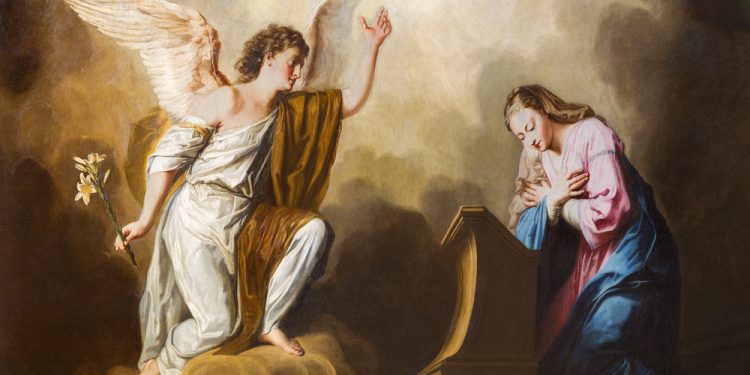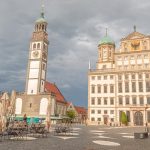
Annunciation
The Annunciation is a day of celebration for Christians throughout the world. Many religions, including the Catholic Church, the Lutheran Church, the Greek Orthodox religion, and others, hold the Annunciation as a very important day of religious life. This day reminds all Christians of the time when the Virgin Mary was asked by the Lord to bring into the world a Savior who would be named Jesus.
The Annunciation in the Holy Bible
The Annunciation is mentioned only a few times in the New Testament of the Holy Bible. St. Matthew begins his book by describing the heritage of Jesus, stating, “The book of the generation of Jesus Christ, the son of David, the son of Abraham:” (St. Matthew 1:1). In Chapter 1:2-16, he continues listing Jesus’ heritage, ending with a conclusion in verse 16, stating, “And Jacob begot Joseph, the husband of Mary, of whom was born Jesus, who is called Christ.” (St. Matthew 1:16).
St. Matthew continues, in Chapter 1, to describe the Annunciation to Mary. He tells of how the Virgin Mary was found with a child before she and Joseph “came together” (St. Matthew 1:18). Joseph had concerns about what to do in this situation until an angel of the Lord appeared to him in his sleep, saying, “Joseph, son of David, fear not to take unto thee Mary thy wife, for that which is conceived in her is of the Holy Ghost. And she shall bring forth a son: and thou shalt call his name JESUS. For he shall save his people from their sins” (St. Matthew 1:20-21).
St. Luke is the only other apostle to mention the Annunciation to the Virgin Mary in the Holy Bible. St. Luke states that “the angel Gabriel was sent from God into a city of Galilee, called Nazareth, to a virgin espoused to a man whose name was Joseph, of the house of David; and the virgin’s name was Mary. And the angel, being come in, said unto her: Hail, full of grace, the Lord is with thee: blessed art thou among women. And the angel said to her: fear not, Mary, for thou hast found grace with God. Behold thou shalt conceive in thy womb, and shalt bring forth a son; and thou shalt call his name Jesus.” (St. Luke 1:26-31)
Mary, being of such a young age, was in wonder as to how this would occur as she had not been with any man. Gabriel answered, “The Holy Ghost shall come upon thee, and the power of the Most High shall overshadow thee. And therefore also the Holy which shall be born of thee shall be called the Son of God.” (St. Luke 1:35)
Mary was chosen to be the Mother of Jesus even before she was born. It was prophesied in Isaiah 7:14 when he wrote, “Therefore the Lord himself shall give you a sign. Behold, a virgin shall conceive, and bear a son, and his name shall be called Emmanuel.” The Lord had chosen Mary to be the Mother of His Son, Jesus. Mary was born without original sin and remained “sin-free” throughout her life.
The Annunciation in the “Lost Books of the Bible”
[NOTE: The stories in the book “Lost Books of the Bible” are stories that are not canonized into the Bible. It is up to the reader to determine the authenticity of each story.]
The Virgin Mary was born to Joachim and Anna in a city called Nazareth. Joachim was a Galilean who lived in Nazareth. Anna was from Bethlehem. The family comes from the genealogy of David, who is the son of Abraham.
During one season of celebrating the feast of the dedication, Joachim, along with others from his tribe, had brought offerings to the temple. Issachar, the high priest, “despised both [Joachim] and his offerings, and asked him why he, who had no children, would presume to appear among those who had? Adding, that his offerings could never be acceptable to God, who was judged by him unworthy to have children.” (The Gospel of the Birth of Mary I:8-9). Joachim departed and went into the wilderness to fast for a period of forty days and nights.
Joachim’s wife, Anna, was very distressed during this time because Joachim had disappeared without notice to her. She had thought she had been widowed. After the forty days, an angel visited Joachim and said that the Lord had heard his prayers.
“Anna, your wife shall bring you a daughter, and you shall call her name Mary; she shall, according to your vow, be devoted to the Lord from her infancy, and be filled with the Holy Ghost from her mother’s womb; she shall neither eat nor drink anything which is unclean, nor shall her conversation be without among the common people, but in the temple of the Lord; that so she may not fall under any slander or suspicion of what is bad. So in the process of her years, as she shall be in a miraculous manner born of one that was barren, so she shall, while yet a virgin, in a way unparalleled, bring forth the Son of the Most High God, who shall be called Jesus, and, according to the signification of his name, be the Saviour of all nations.” (The Gospel of the Birth of Mary II:9-12).
Joachim was then told to return to Jerusalem, and Anna would be waiting for him at the golden gate. The angel also visited Anna and told her the same as was told to Joachim. Anna was also told, as a sign of the truth, to go to the golden gate where she would see Joachim. Doing what the angel said, Anna and Joachim met at the gate and then returned home. Not long after, Anna was with child, and a daughter was born, whom was called Mary (The Gospel of the Birth of Mary III:11).
At the age of three, the Virgin Mary was sent to live in the temple of the Lord, where the Lord took care of her. No evil could come near her as the Lord had sent angels to be with her. The angels conversed with Mary, “and every day [Mary] received visitors from God, which preserved her from all sorts of evil, and caused her to abound with all good things;” (The Gospel of the Birth of Mary V:2).
When Mary reached the age of 14, there was a public order in which all virgins of this age were to return home to be married. Mary stated she could not do this as she had taken a vow of virginity to the Lord. The high priest had a dilemma of what to do. He proceeded to bring together all principal members of Jerusalem and its close neighbors to discuss the matter. They turned to the Lord in prayer, and a voice was heard from the dark, saying, “that it must be inquired or sought out by a prophecy of Isaiah to whom the Virgin should be given and be betrothed; for Isaiah saith, there shall come forth a rod out of the stem of Jesse, and a flower shall spring out of its root, and the Spirit of the Lord shall rest upon him.” (The Gospel of the Birth of Mary V:1-15).
The high priest called all from the house of David who were marriage eligible. Those eligible were to bring one rod. It was from one of the men’s rods that “a flower should bud forth, and on the top of it the Spirit of the Lord should sit in the appearance of a dove; he should be the man to whom the Virgin should be given and be betrothed.” (The Gospel of the Birth of Mary V:17).
Joseph was, at the time, an older widower and included as an eligible male. When he saw the young Virgin, he thought he should not be a person considered as he was on in years. “[He] drew back his rod when everyone besides presented his. So that when nothing appeared agreeable to the heavenly voice, the high priest judged it proper to consult God again, who answered that he to whom the virgin was to be betrothed was the only person of those who were brought together, who had not brought his rod.” (The Gospel of the Birth of Mary VI:1-3). Once Joseph brought forth his rod, a dove ascended upon it. The Virgin Mary was to be betrothed to Joseph.
For about three months after this decision, Joseph had to return to his carpentry work in another city. While he was gone, the Virgin Mary returned to Galilee. It was during this time that God sent the angel Gabriel to the Virgin Mary. Gabriel said to her, “Therefore, while you are a Virgin, you shall conceive without sin, and bring forth a son. And he shall be called the Son of the Highest” (The Gospel of the Birth of Mary VII:10,12). It was at this time the Virgin Mary was conceived with the Son of God, Jesus.
When Joseph returned three months later, his intentions were to marry the Virgin Mary. However, once returned, he saw that the Virgin Mary was with child. He was distressed and did not know what to do. While contemplating what to do, an “angel of the Lord appeared to him in his sleep, and said, ‘Joseph, son of David, fear not; be not willing to entertain any suspicion of the Virgin’s being guilty of fornication, or to think anything amiss of her, neither be afraid to take her to wife; for that which is begotten in her and now distresses your mind, is not the work of man, but the Holy Ghost. For she of all women is that only Virgin who shall bring forth the Son of God, and you shall call his name Jesus, that is, Saviour: for he will save his people from their sins.'” (The Gospel of the Birth of Mary VIII: 8-11).
The Annunciation Celebration
The first mention of celebrating the Annunciation is not specifically known. One possibility for the first Annunciation celebration would be around the time of the Council of Ephesus (c. 431). A Bishop of Constantinople, St. Proclus (d. 446), mentioned a feast “of the coming of Our Lord and Saviour when He vested Himself with the nature of man (quo hominum genus indutus),” which was celebrated during the entire fifth century. However, some suggest that this could mean the day when Jesus was born and not the day of conception.
A more specific time period for the feast of the Annunciation was written in the Sacramentarium of Pope Gelasius, who died in 496, and in the Sacramentarium of St. Gregory, who died in 604. These manuscripts have recorded a time that mentions the Annunciation day.
The current celebration date of the Annunciation occurs on March 25th, which is nine months before the birth of Jesus on December 25th. In some religions, if March 25th falls during Holy Week, the date will be moved to a date not within Holy Week. In other religions, if March 25th falls during Holy Week, it will remain on that day, and dual celebrations occur.
In celebrating the Annunciation, the color white is used during church services. The color white is used for this celebration as it relates to purity, respect, virtue, and holiness.
In the Catholic religion, parishioners say a prayer to St. Mary for intercession with her son, Jesus. The prayer to St. Mary begins with the acknowledgment of Mary’s grace when the angel Gabriel, sent by God to Mary, stated, “Hail, full of grace, the Lord is with thee: blessed art thou among women” (St. Luke 1:28). The Hail Mary prayer continues by honoring Jesus with the words “and blessed is the fruit of thy womb, Jesus.” The prayer ends with a plea from parishioners to St. Mary in asking for forgiveness of sins. The Hail Mary is recited in full with the following words:
Hail Mary, full of grace, the Lord is with thee.
Blessed art thou amongst women, and blessed is the fruit of thy womb, Jesus.
Holy Mary, Mother of God, pray for us sinners, now and at the hour of our death.
Amen.
Conclusion
Although it does not appear many times throughout the books of the apostles in the New Testament, the Annunciation itself is not the “highlight” or “purpose” of the time Jesus spent on Earth. The Annunciation is, however, a time of celebration of the Virgin Mary conceiving the Savior, Jesus. It is a time of celebration for Christians around the world as a most blessed time of the year.
When is the Annunciation?
The Annunciation is not a floating holiday and always falls on March 25 of each year.








